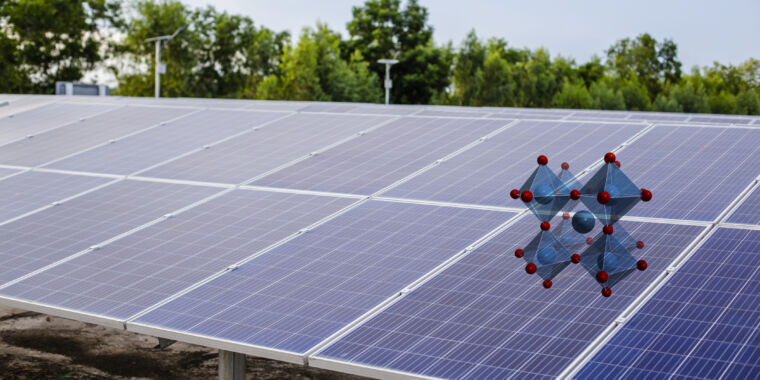- cross-posted to:
- [email protected]
- cross-posted to:
- [email protected]
So, the team … got efficiencies in the area of 33 to 34 percent. They also sent a sample to a European test lab, which came out with an efficiency of 33.7 percent. The researchers have a few ideas that should boost this to 35 percent, but didn’t attempt them for this paper. For comparison, the maximum efficiency for silicon alone is in the area of 27 percent, so that represents a very significant boost and is one of the highest perovskite/silicon combinations ever reported.
Love this research and I hope solar eventually beats ICE engines for efficiency.
However…
The crystals were reasonably stable when simply exposed to light. But the combination of light and heat caused a more significant decay in performance. The researchers say that “devices maintain ≥90 percent of their initial performance up to 1,000 hours,” but a decay of up to 10 percent in about three months is not ready for commercial deployment. So, still some work to do there.
The differences in efficiency result in very different things.
ICE - heat, smoke, carbon, pollution
Solar -
Solar still indirectly creates pollution in the form of production of the materials needed, manufacturing, etc. Also, huge solar farms can have a significant detrimental impact on local ecosystems, in addition to the large amount of waste created from old panels: https://hbr.org/2021/06/the-dark-side-of-solar-power
https://www.popsci.com/environment/solar-farm-construction-epa-water-violations/
It’s still better than ICE, as that also creates waste and actively pollutes, but it’s still notable and hopefully over time those negative byproduct can also be eliminated/significantly reduced.
Agreed!
However ICE arguments include efficiency so that’ll be one major obstacle hurdled
I hope solar eventually beats ICE engines for efficiency
I’m not sure your comment makes a lot of sense. The problem with solar isn’t that it’s not as efficient as internal combustion engines, it’s that you can’t generate electricity on-demand. But it’s already a cheaper form of energy than burning fossil fuels in many countries.
Even conventional solar panels work better when they are cool. Someone smart figured out that you can pump water through them and then use that hot water in your house. You get hot water while making your solar panels more productive. Of course they are crazy expensive.
ICE engines
Internal combustion engine engines.
Sorry, I forgot to go to ATM machine before I wrote that comment
Do you still remember your PIN number though?
No, but I have a device with a LCD display where I can look it up
Clearly
Given that the first perovskites studied had lifespans that could be measured in minutes, this is great progress, but the fundamental problem is that as a class of materials they just don’t want to exist outside of an inert atmosphere. Without significant progress in stability and encapsulation materials, they’re more of a research curiosity than a viable real-world PV tech.
We’re reaching the limit for photovoltaics. Really need to pour money into optical rectennas.
Is a rectenna like that thing Cartman got one time?

Nice
Current panel efficiency is at roughly 22%. A 34% efficient panel would increase current solar generation to 133% just by replacing current panels. That’s much easier then building new solar generation plants. This would move the “total energy produced Earth by solar” amount from the current 5.5% to 7.35%
That’s a pretty stunning improvement for a comparably easy lift.
The longevity numbers on these are abysmal, though. Like nearly useless after a year.
I’m not interested in hearing about perovskites breaking efficiency records when the longevity issue isn’t solved.
Not only that, they’re terrible on the toxicity front.
Oh no doubt it’s a massive improvement. It’s just we can see even better numbers and for cheaper once we crack the materials and lithographic constraints of rectenna diode construction. Mass production of those babies would be revolutionary in terms of solar energy. It’d straight up outcompete fossil and nuclear even considering having to build energy storage. Hell it’d be revolutionary even if we make them just for the infrared wavelength.
Did not know that rectenna panels could harvest infrared radiation at night. Interesting technology
34% is 155% of 22%, so an even bigger increase!
Incredible.
I’ve heard perovskite-based solar panels have less scary runoffs if they go bad but I haven’t found anything solid on that.
All these news about in-development technologies in the renewable energy sector are causing real fatigue for me. This would be great news if it was commercialy viable, but it isn’t. It never is. If all the news about amazing new battery technologies were viable, we’d have 10x the capacity by now with cells that have zero fire risk and last 10 million cycles. But it’s always laboratory conditions.
Gonna be honest, I kinda stopped paying attention to news like this, it’s a flood of theoretical advancements. I care about it when I can buy it.
That being said, obviosuly the state-of-the-art technology has made significant advancements in the last 10 years, but it’s been incremental (it always is) and nowhere near the numbers that are thrown around in reports and articles like this.
In the last 30 years, batteries have gotten about 10 times more powerful at a tenth the size for about 1% of the cost. Every advance that got us to this point was just “stuck in the lab” prior to its release. And if you don’t think incremental change can be significant, after hearing those numbers I provided above, perhaps you should read about compound interest.
Also, if you don’t want to be let down by news of developments at the lab stage, which certainly don’t always become viable, why are you reading posts in a technology community? That seems self-destructive.
We’re saying the same thing with different words. Your prespective it’s “its’s so great”, mine is “it’s gotten slowly better”. I’m sick and tired of reading about some irrelevant technological breakthrough with +10% solar efficiency or +30% battery density in some laboratory every 2 weeks. Actual change comes in (very) low single digit percentages for efficency of panels per year (or similar for battery density). Not once in the last 30 years did we have an actual jump for stuff you can buy (within a short timeframe) that comes close to the hyperbole in these reports. The advancement in price can probably be attributed to scale of production most of all though. Who would buy
why are you reading posts in a technology community? That seems self-destructive. Go actually look at that community maybe? Only the energy-pseudo-news in here is like that. The rest is mostly actual (relevant) news around technology and/or companies in that space. That’s my ENTIRE POINT. Thanks for emphasizing it. It’s not just that: renewable energy news has been like that for actual decades, no other field has this problem as far as I can tell.
Cancer treatments, longevity treatments, regrowing teeth, every fucking mouse trial that has been talked about for the last 20 years, CRISPR saving the world.
And then you hear about immune therapy cancer treatments, using CRISPR and our extensive knowledge of cancer from decades of research. Or our better diagnostics for cancer leading to better cancer treatment outcomes due to early detection. Or regrowing teeth! (In certain circumstances.) Or, yes, new solar panels with 34% efficiency…for 3 months, at which time they’re only slightly better than existing panels. Or two new ways to make blue pigment in the last two DECADES.
Science is hard, and all of it is standing on the shoulders of giants. And when getting money to do that research, which is another way of saying “trying things you think might work in the hopes of something new”, relies on convincing people that this one idea could be the next big thing, hype is built into the system. So, again, if you don’t want hype, look at new products. If you want to hear about what researchers are working on, don’t expect that everything is going to come to fruition. Even the failed ideas help build the foundation that future researchers will be working from.
Adding on to what GreyEyedGhost said, since the year 2000 the price of solar power (per watt) has fallen by more than 50x. Because of this huge drop in price the installed solar capacity has been doubling every 3 years. That means that in the time since 2020 we’ve built more solar capacity than we did in the previous 20 years combined.
If that’s not good enough then idk. Imagine holding any other technology to that standard. The model T came out almost 100 years ago for an inflation adjusted price of $27,000 and with an MPG of 7.5. ICE cars today are better in a lot of other ways but they are not 50x cheaper and they are not 50x more fuel efficient than that.
You guys really seem to have a hard time to understand my point, so that’s on me. Clearly I didn’t explain it very well. First, look at my reply to GreyEyedGhost. Let me reemphasize from that post: I have never said or intended to imply that there were no advances made in the last 20 or 30 years. I have no idea why you keep bringing up long term (price) developments at all. It wasn’t even about price at all, please go back and read my comment again.
Let’s address your points: Of course stuff has gotten cheaper, as that’s how “scale of production” works. That’s how the price AND the “doubling of installed capacity every 3 years” were achieved. Nothing about that is a technological breakthrough, it’s just production capacity you need for this.
Of course there were improvements in technology (solar efficiency, battery density and others, wind “stuff”, …). But none of those were anywhere near those claims that you read in these pseudo-news. It’s a percent here or there. Look at the nice graph on Wikipedia. See how those lines go up very very little per year? Yet in the article that sparked this thread, it’s a whopping 10%! Unfortunately, the cells fall apart when they get warm. No idea how a solar panel would ever get warm. But hey, let’s make another headline claiming amazing gains, can’t ever have enough of those!
I have never said or intended to imply that there were no advances made in the last 20 or 30 years.
This would be great news if it was commercialy viable, but it isn’t. It NEVER is.
That’s pretty definite by any measure.
But I get it. 99% of the announcements go nowhere. And it’s worse if an announcement is just hype or hyperbole. However, in science we have to do the 99% to find the 1% of true advancements.
So
ofif your point is just that you don’t like the hyperbole, then using hyperbole yourself is not doing yourself any favour. Of course people are going to be more measured and realistic in reply to your blatant over-statements and denials.That’s pretty definite by any measure.
Not really, sorry. The complaint still is that the announcements are of some magical huge improvement that is just not real. They might work in a prototype, maybe in a laboratory, or the thing just disintegrates after being exposed to water or something. Of course the results influence existing or future products, that’s how the real world improvements come about.
By the time you modify the prototype (or whatever) into something that is actually real world production viable, with a reasonable lifespan and production costs, there’s barely anything left in common with the hyperbolic announcement about fantasy stuff.
I stand by that statement you highlighted. And the fact that it isn’t hyperbole. With all of these achievements being released as clickbait news articles, somehow when something exciting it’s actually everything the market, it’s crickets. Like solid state or “salt” batteries are starting to become products, seen any articles on those posted here recently? Or in news outlets in general? I haven’t, but I honestly could’ve just missed them, or they didn’t gain as much traction.
We must read very different sources. For example, I’ve seen plenty of articles and videos just this week for Samsung’s 1,000 km EV battery with its 20 year life span, and 9-minute charging. If you consider those combined features incremental, then I can see why you’re frustrated. It’s already in production, and has been delivered to "customers. Samsung are even gearing up for out-sourced mass manufacturing. That’s well beyond some theoretical lab experiment that has no chance of seeing the light of day.
I don’t disagree with you about the 99% over-hype being a PITA. But to adamantly state you’re seeing nothing reported on, while admitting you “could’ve just missed them” doesn’t sound convincing. Besides, it only takes a single article for you to be wrong about it being “never.”
deleted by creator
I really don’t know why people are downvoting you. The internet is full of journalistic coverage of new developments in the field of photovoltaic and electric batteries, and journalistic coverage of science is generally… poor. They overstate the importance of everything because they wanna make clickbait, and the result is that it feels like there’s a nonstop of development, of new battery technologies that are gonna change the world… It’s frankly exhausting, like, give me real data as you say, such as capacity installed per year, trends in battery capacities and prices and the reasons for that, and so on and so forth.
Maybe they down vote because they think I don’t like the research or think it’s pointless (far from it). The only thing I dislike is the reporting about it, and even there mostly the clickbaity headlines intentionally misrepresenting the facts. It’s clearly intentional, because when reading the articles it usually becomes quite clear that the author was well aware.
I can also imagine that articles like that stop at least a couple of people here and there from adopting solar for their home, cause they read what they think means that there’s about to be a 10% efficiency increase for panels. Clearly that’s a time to wait, not to buy! The number is people that only read the headline is probably uncomfortable high, but I got no clue what the actual percentage is, or if those that don’t click through take the headline at face value…
Yeah, in my opinion you were clear about that in your comment, so I guess people are just being outraged assuming that “they’re not supporting solar!!!”
You’re right, there’s no point in general public following these news. When a lab publishes such, it’s meant for other researchers. The other researchers can try to build upon. It might become useful or as an inventor put it - discover a thousand ways of how not to do it.
When you see big numbers reported but see the deployed improvements in single digits, that’s coz the big number improvement gets deployed many years later.







